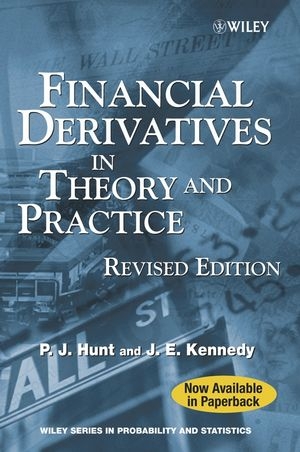
Financial Derivatives in Theory and Practice
John Wiley & Sons Inc (Verlag)
978-0-470-86359-6 (ISBN)
The term Financial Derivative is a very broad term which has come to mean any financial transaction whose value depends on the underlying value of the asset concerned. Sophisticated statistical modelling of derivatives enables practitioners in the banking industry to reduce financial risk and ultimately increase profits made from these transactions. The book originally published in March 2000 to widespread acclaim. This revised edition has been updated with minor corrections and new references, and now includes a chapter of exercises and solutions, enabling use as a course text.
Comprehensive introduction to the theory and practice of financial derivatives.
Discusses and elaborates on the theory of interest rate derivatives, an area of increasing interest.
Divided into two self-contained parts ? the first concentrating on the theory of stochastic calculus, and the second describes in detail the pricing of a number of different derivatives in practice.
Written by well respected academics with experience in the banking industry.
A valuable text for practitioners in research departments of all banking and finance sectors. Academic researchers and graduate students working in mathematical finance.
Philip Hunt is the author of Financial Derivatives in Theory and Practice, Revised Edition, published by Wiley. Joanne Kennedy is the author of Financial Derivatives in Theory and Practice, Revised Edition, published by Wiley.
Preface to revised edition xv
Preface xvii
Acknowledgements xxi
Part I: Theory 1
1Single-Period option pricing 3
2 Brownian Motion 19
3 Martingales
3.5 Local martingales and semimartingales 56
3.5.1 The space cMloc56
3.5.2 Semimartingales 59
3.6 Supermartingales and the Doob—Meyer decomposition 61
4 StochasticIntegration63
4.1 Outline 63
4.2 Predictable processes 65
4.3 Stochastic integrals: the L2 theory 67
4.3.1 The simplest integral 68
4.3.2 The Hilbert space L2 (M) 69
4.3.3 The L2 integral 70
4.3.4 Modes of convergence to H • M 72
4.4 Properties of the stochastic integral 74
4.5 Extensionsvialocalization77
4.5.1 Continuous local martingales as integrators 77
4.5.2 Semimartingales as integrators 78
4.5.3 The end of the road! 80
4.6 Stochastic calculus: Itô’s formula 81
4.6.1 Integration by parts and Itô’s formula 81
4.6.2 Differential notation 83
4.6.3 Multidimensional version of Itô’s formula 85
4.6.4 Lévy’stheorem88
5 GirsanovandMartingaleRepresentation91
5.1 Equivalent probability measures and the Radon—Nikodým derivative 91
5.1.1 Basic results and properties 91
5.1.2 Equivalent and locally equivalent measures on a filtered space 95
5.1.3 Novikov’s condition 97
5.2 Girsanov’s theorem 99
5.2.1 Girsanov’s theorem for continuous semimartingales 99
5.2.2 Girsanov’s theorem for Brownian motion 101
5.3 Martingale representation theorem 105
5.3.1 The space I2 (M) and its orthogonal complement 106
5.3.2 Martingale measures and the martingale representation theorem 110
5.3.3 Extensions and the Brownian case 111
6 Stochastic Differential Equations 115
6.1 Introduction 115
6.2 Formal definition of an SDE 116
6.3 An aside on the canonical set-up 117
6.4 Weak and strong solutions 119
6.4.2 Strong solutions 121
6.4.3 Tying together strong and weak 124
6.5 Establishing existence and uniqueness:Itô theory 125
6.5.1 Picard—Lindelöf iteration and ODEs 126
6.5.2 A technical lemma 127
6.5.3 Existence and uniqueness for Lipschitz coefficients 130
6.6 Strong Markov property 134
6.7 Martingale representation revisited 139
7 Option Pricing in Continuous Time 141
7.1 Asset price processes and trading strategies 142
7.1.1 A model for asset prices 142
7.1.2 Self-financing trading strategies 144
7.2 Pricing European options 146
7.2.1 Option value as a solution to a PDE 147
7.2.2 Option pricing via an equivalent martingale measure 149
7.3 Continuous time theory 151
7.3.1 Information within the economy 152
7.3.2 Units, numeraires and martingale measures 153
7.3.3 Arbitrage and admissible strategies 158
7.3.4 Derivative pricing in an arbitrage-free economy 163
7.3.5 Completeness 164
7.3.6 Pricing kernels 173
7.4 Extensions 176
7.4.1 General payout schedules 176
7.4.2 Controlled derivative payouts 178
7.4.3 More general asset price processes 179
7.4.4 Infinite trading horizon 180
8 Dynamic Term Structure Models 183
8.1 Introduction 183
8.2 An economy of pure discount bonds 183
8.3 Modelling the term structure 187
8.3.1 Pure discount bond models 191
8.3.2 Pricing kernel approach 191
8.3.3 Numeraire models 192
8.3.4 Finite variation kernel models 194
8.3.5 Absolutely continuous (FVK) models 197
8.3.6 Short-rate models 197
8.3.7 Heath—Jarrow—Morton models 200
8.3.8 Flesaker—Hughston models 206
References 423
Index 427
| Erscheint lt. Verlag | 26.5.2004 |
|---|---|
| Reihe/Serie | Wiley Series in Probability and Statistics |
| Verlagsort | New York |
| Sprache | englisch |
| Maße | 153 x 230 mm |
| Gewicht | 680 g |
| Themenwelt | Mathematik / Informatik ► Mathematik ► Angewandte Mathematik |
| Mathematik / Informatik ► Mathematik ► Wahrscheinlichkeit / Kombinatorik | |
| Wirtschaft ► Betriebswirtschaft / Management ► Finanzierung | |
| ISBN-10 | 0-470-86359-5 / 0470863595 |
| ISBN-13 | 978-0-470-86359-6 / 9780470863596 |
| Zustand | Neuware |
| Informationen gemäß Produktsicherheitsverordnung (GPSR) | |
| Haben Sie eine Frage zum Produkt? |
aus dem Bereich


